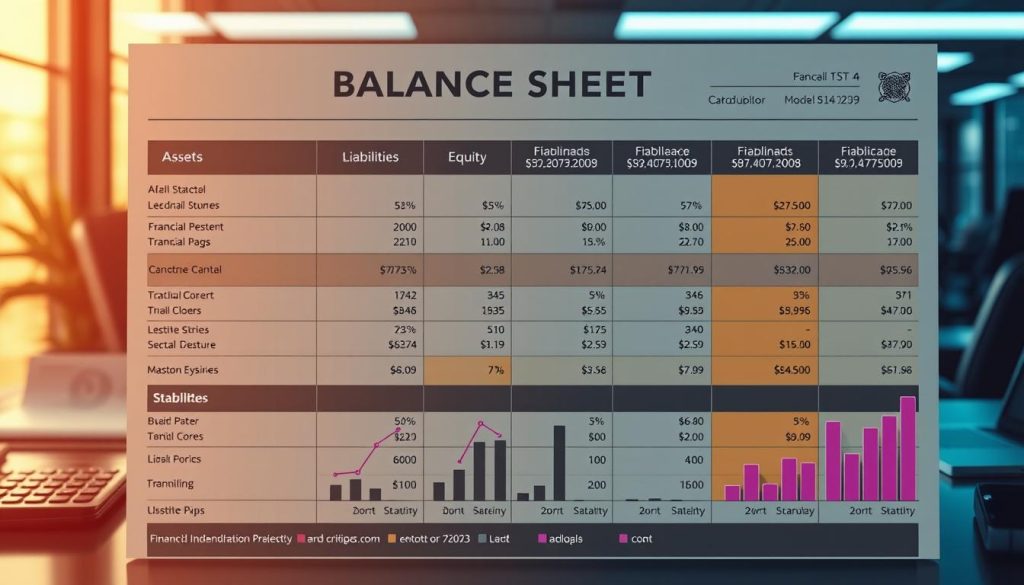As an aspiring investor, entrepreneur, or manager, knowing how to read financial statements is key. They show you how well a company is doing and its financial health. This guide will teach you how to understand balance sheets, income statements, and cash flow statements.
Financial statements are key for checking a company’s finances, how well it’s doing, and its cash flows1. They make it easy to compare a company’s finances with others in different fields and over time2. By learning to read these statements, you can make better investment choices and manage your finances better.
Key Takeaways
- Financial statements offer a window into a company’s financial health and performance.
- Balance sheets, income statements, and cash flow statements are the three primary financial statements.
- Understanding financial ratios and analysis techniques can help you assess a company’s financial standing.
- Proper financial statement interpretation is crucial for making informed investment and business decisions.
- Developing financial literacy is a valuable skill for investors, entrepreneurs, and managers.
- https://balamga.com/the-best-kept-secrets-of-travel-essentials-for-women/
Fundamentals of Financial Statements
Financial statements are written records that show a company’s financial health and activities3. They act as a window into a business’s strength and operations. They give a full view of its assets, liabilities, equity, revenue, and expenses3.
What are Financial Statements?
Financial statements share a company’s financial info with stakeholders like investors, lenders, and regulators3. They come out yearly, but public companies might share them more often, like every three months3. For companies, internal statements can be more detailed and flexible, often reporting by department and more often, like every week or month3.
The Three Primary Financial Statements
The main financial statements are the balance sheet, income statement, and cash flow statement3. The balance sheet shows the company’s assets, debts, and equity at a certain time3. The income statement shows how well the company did over a period, by adding up what it made and spent3. The cash flow statement tells about the company’s cash, where it came from, and where it went, helping investors and creditors understand its financial health3.
Together, these statements give a full picture of a company’s finances, helping stakeholders make smart choices3.
| Financial Statement | Purpose |
|---|---|
| Balance Sheet | Shows a company’s assets, debts, and equity at a certain time4. |
| Income Statement | Shows a company’s profits over time, with its income and costs4. |
| Cash Flow Statement | Focuses on the company’s cash, showing where it comes from and goes, and its investment and growth4. |
Learning about these three financial statements helps you understand a company’s financial health and performance3.
financial statements: Decoding the Balance Sheet
The balance sheet is key to understanding a company’s assets, liabilities, and shareholders’ equity at a certain time5. It shows the “book value” of a company, giving insights into its financial health and stability5.
Assets: What the Company Owns
Assets are things a company owns that can be counted5. They are split into current assets and non-current assets6. Current assets turn into cash within a year, like cash, inventory, and accounts receivable6. Non-current assets are long-term investments, like property, equipment, and patents6.
Liabilities and Shareholders’ Equity: What the Company Owes
Liabilities are what a company owes, like payroll and rent5. They’re split into current liabilities and non-current liabilities6. Shareholders’ equity shows the company’s net worth, owned by the shareholders5.
Understanding the balance sheet helps investors and analysts see a company’s financial health and growth potential5. It, along with the income statement and cash flow statement, gives a full view of a company’s finances5.
| Financial Metric | ExxonMobil Corporation (2023) |
|---|---|
| Total Assets | $376.3 billion7 |
| Total Liabilities | $163.8 billion7 |
| Total Equity | $212.5 billion7 |
| Total Revenue | $344.6 billion7 |
| Total Costs | $291.8 billion7 |
| Net Income | $36 billion7 |

“Understanding the balance sheet is crucial for evaluating a company’s financial health and stability.”
Interpreting the Income Statement
The income statement is key for understanding a company’s financial health over time. It shows the company’s revenue, expenses, and profits. This info is vital for business owners, entrepreneurs, and investors8.
Revenue and Expenses: The Building Blocks
The income statement starts with revenue, which is the company’s main earnings from selling products or services8. It also includes non-operating revenue like interest or rent8. Then, it subtracts expenses like the cost of making goods, selling, and running the business. This gives us the net income8.
Important parts of the income statement are revenue, cost of goods sold, gross profit, operating income, income before taxes, and net income8. The single-step income statement gives a simple look at revenue and expenses. The multi-step income statement shows more about different profit levels8.
| Metric | Description |
|---|---|
| Revenue | Shows the money made from the company’s main activities. This includes selling products or services9. |
| Cost of Goods Sold (COGS) | The direct costs to make or deliver the goods and services. COGS affects the company’s gross profit margin9. |
| Gross Profit | The revenue minus the cost of goods sold. It shows the profit before looking at operating costs8. |
| Operating Expenses | Day-to-day business costs, like sales, marketing, and admin expenses9. |
| Operating Income | Profit before interest and taxes (EBIT), showing the core business profit8. |
| Net Income | The final profit after all costs and expenses, including interest, taxes, and more89. |
Knowing how to read the income statement is key for making smart financial choices10. Analysts look at it to see how a company is doing and its future growth10. By understanding the income statement, you can see how a company makes money, its costs, and profits. This helps in making better business decisions10.

“The income statement provides crucial financial information about a company’s business activities over a specific period. It highlights the company’s revenue generation and associated costs.”
Analyzing Cash Flow: The Statement of Cash Flows
The cash flow statement is key for understanding a business’s cash movements over time11. It’s divided into three parts: cash flow from operating activities, cash flow from investing activities, and cash flow from financing activities11.
This statement shows how well a company can manage its cash. It’s different from profit, which is what’s left after expenses are subtracted from revenue12. Cash flow is about the actual cash moving in and out of the company12.
Company A began with about $10.75 billion in cash and ended with $14.26 billion12. They made a net income of $37.037 million and had $53.666 million in cash generated by operating activities12. But, they spent more on investing activities and financing activities, resulting in a cash outflow12.
A positive cash flow means a company is bringing in more cash than it spends12. On the other hand, negative cash flow could be from spending more than earning or expanding the business12. This info helps investors and managers make smart choices11.
The cash flow statement is vital for checking a company’s financial health11. By looking at operating, investing, and financing activities, businesses can make better decisions and stay financially stable13.

Conclusion: Mastering Financial Literacy
Learning about financial statements is key for investors, entrepreneurs, managers, and employees. By looking at balance sheets14, income statements14, and cash flow statements14, you can understand a company’s financial health. This includes debts, profits, and operational costs14.
While experts like accountants know these documents well, you can also learn to read them. This skill helps you make better business choices and talk better with important people.
To get better at finance, think about taking courses or working with finance pros like accountants15. Reading books and articles, and joining financial groups can also help15. Focus on cash flow, budgeting, and financial statements15.
Setting financial goals and watching your spending are important steps. Creating a detailed budget, looking into investments, and having a financial safety net are also key15.
Financial literacy is more than just knowing numbers. It’s about making smart choices, avoiding risks, and aiming for long-term success15. With the right tools and effort, you can use financial statements to change how you handle money. This can lead to growth and success in your business or personal life.
FAQ
What are financial statements and why are they important?
Financial statements show a company’s health. They are hard to understand without them. Knowing how a company is doing is key for investors, entrepreneurs, and managers.
What are the three primary financial statements?
The main financial statements are the balance sheet, income statement, and cash flow statement. This is what the second source says.
What information does the balance sheet provide?
The balance sheet gives a snapshot of a company’s assets, liabilities, and equity at a certain time. This is explained in the guide.
What does the income statement cover?
The income statement shows a company’s profits over time. It includes revenue, gains, expenses, and losses, as the guide explains.
What does the cash flow statement demonstrate?
The cash flow statement shows what happened to a company’s cash over a period. It helps see if the company can make and use cash well.
Why is understanding financial statements important?
Knowing financial statements is crucial for investors, entrepreneurs, managers, and employees. It helps make better decisions and talk better with important people, as the guide says.

